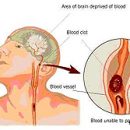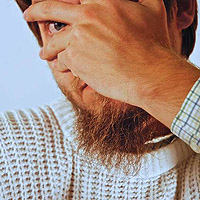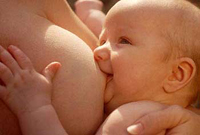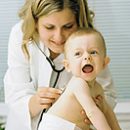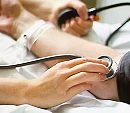As a rule, family members, as well as educators of children suffering from epilepsy, are concerned about the possibility of getting injuries as a result of attacks. How to avoid this danger?
Content
There are three main reasons for justifying the need to limit the actions of children with epilepsy. First, it is a very real danger of getting an injury to the child during an attack due to possible unsuccessful falls, burns, cuts and abrasions, bone and teeth fractures, dislocation. Secondly, it is the need to protect the child from events and circumstances capable of provoking bouts from him. These events include, for example, flashes and flashes of light (photostimulation), lack of sleep, alcohol intake, overheating. And finally, in exceptional cases, restrictions may be due to the fear of emotional damage, mental injury in a child.
For some children, interim limits should be introduced, for example, in the following situations:
- within 2-3 months after the first-occurring attack;
- Since the beginning of drug treatment and until it becomes clear that the further appearance of the attacks is extremely unlikely;
- within a few months after the cancellation of anticonvulsant drugs.
Restrictions can be administered indefinitely for children with persistently recurrent (repeated), non-treating attacks. In children with progressive forms of epilepsy, the conditions for the introduction and action of those, or other restrictions should be revised over time.
Factors affecting the introduction of restrictions
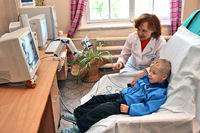
Significant in making decisions on prohibitions and restrictions is given to the following factors:
The age of the child. All children are allowed to do only what corresponds to their age, temperament and mental level. For children under 8 years old, all restrictions must be the form of prohibitions or mandatory rules. At an older age, children begin to realize the need and importance of adopted restrictions, so their consent should be achieved on the manifestation of special restraints in those situations and in those moments of time when ordinary rules of behavior do not require.
Types of attacks. Inserted bans and restrictions depend on the type of attacks inherent in this child. Attacks that are not related to loss of consciousness, or flowing during sleep require only minor lifestyle changes. But the attacks, accompanied by the loss of consciousness, of course, include the child to the most serious risk risk group related to injuries.
Frequency of attacks. Children with rare attacks usually do not need any restrictions. This is quite reasonable, if, for example, during the year there was only one attack. On the contrary, with very frequent absans (small attacks with the shutdown of consciousness), seizures of various kinds, as well as in children with recently diagnosed epilepsy, requires the introduction of appropriate restrictions before establishing complete control over the attacks.
Time and place of attacks. Some children have attacks only during sleep, that is, at the moment when the child is in a relatively safe and convenient position. At the other children, attacks arise at the active time of the day and can be provoked by flashing light, glare of a television screen or a video monitor.
These circumstances can be overcome or to some extent to limit their impact, using, for example, sunglasses, as well as closing one eye. In those rare cases where this kind of situation lasts long, they become a source of permanent problems.
The fascination of the child. A very important factor is the ability of a child to comply with a number of conditions that limit its activities, and the ability to bear for this permanent responsibility. Of particular importance, such self-organization acquires in adolescence, as well as in those families who do not have the opportunity to regularly buy medicines.
Related diagnoses. The presence of a severe concomitant diagnosis, for example, a physical or mental disadvantage, can also be an obstacle to the introduction of restrictions.
Possible restrictions
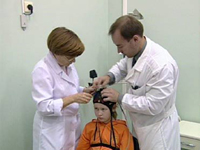
The following is a description of some restrictions in relation to concrete circumstances.
In the House. Little children should never be left in the bath one unattended. For older children, it is preferable to use the shower, but one should never lock the door to the bathroom. The loss of consciousness can lead to a drop in water, and at the same time it is easy enough to choke.
It is also necessary to avoid sleeping surfaces (for example, water mattress), covered and pillows capable of causing difficulty breathing and, as a result of this, suffocation. This is especially true of beds of babies and young children. And, of course, it is necessary to exclude the stay of children near open fire, hot furnaces and ovens, on stairs.
Outside the family. Nanny, teacher of the children's preschool institution, teacher at school, as well as any other person carrying responsibility for the child, should be informed about the likelihood of attacks.
It is very important that adults watching the child have been familiar with the basic information about the attacks of epilepsy associated with them, as well as the necessary precautions and first aid rules. If there is an opportunity, then at the appropriate age, the child must attend a secondary school. Relatives or the attending physician must inform the school medical staff about the presence of attacks in the child and the restrictions adopted in connection with this.
However, the child must be allowed to participate in all sports and mass events held within the school. Regular physical activity and adherence to adequate skills in training in no way can adversely affect the course of the disease and, especially, aggravate it.
In cases where there is a high risk of epileptic status (a very long attack or several attacks following one by one) in a child, restrictions may be less stringent only provided that those who are constantly adjacent adult educators have been trained in advance management and the use of high-speed anticonvulsant preparations (for example, candles with diazepam). If during the attack the child occurs involuntary urination, it would be reasonable to keep spare clothes in this case at school.
In general, classmates better know about possible attacks in their comrade, especially if the attacks proceed to generalized or have a pronounced picture. It often takes a lot of time, while the family is bothering with the need to disclose the diagnosis of the child, but this insection is required for a condescending and incentive attitude.
Sports and entertainment
Swimming, rowing, surfing. All children engaged in water sports, it is necessary to continuously observe an experienced rescue. Swim best with friends. It is prudent to use a life jacket. The main factors on which attention should be paid is the age of the child, the frequency of attacks, reliability and care of control over its actions.
Scuba diving and jumping. These are the few sports that should avoid children with epilepsy.
Overnights in the campaign and friends. Adult, carrying in these situations responsibility for children, should be informed about the form of attacks in a child, and the rules for first aid, and the ways of notifying the family, if necessary, is similar to how it is accepted at school or with any other active and physical classes with children.
Travel by plane, as well as travel by regions having underdeveloped medical care. While there is access to qualified medical care, there is no need to somehow limit children in travels. Related obligations in advance to think about the trip and provide those necessary measures that will inevitably need to be first aid during an attack.
There may be such situations when it is wiser to interrupt the journey, or urgently apply high-speed anticonvulsant drugs. The decision should be made based on the analytical comparison of the likely risk and undoubted benefits for the child.
Climbing rope, trees, rocks. Risky risks to height need to prohibit. This applies not only to children with epilepsy. Such prohibitions are dictated by common sense.
Running on cross-country skiers, Running on long distances and other sports requiring endurance. It is very unlikely that intensive sports are able to negatively affect the attacks. Good check and proof of sustainability to the attacks, preparatory and training sessions for competitions may be.
Cycling, skating, rollers, roller board. Everyone without exception to children, including children with epilepsy, should be avoided by lively streets and squares when riding on listed sports shells. In addition, regardless of their attacks, children when riding are obliged to wear protective helmets, knee pads and elbows. If the attacks are not controlled or revealed quite recently, then cycling, skating, rollers and the board must be discontinued.
Football, Rugby, Handmade Ball, Hockey (Contact Sports). Light injuries of the head, possible in the class of sports - this is definitely injuries, but not so serious to cause an attack.
Car control
Restrictions on driver's license are different in different countries. In some states, they do not exist, it is enough to have only the permission of a doctor for movement in general. In others, if there is a diagnosis in history, there is a period of absence in a patient attacks with a duration of 3 months to 1 year.
People with an active form of epilepsy, sitting behind the wheel, must be warned about dangerous situations that may occur when driving control, and such a warning must be done in writing.
Patients with drug-resistant treatment forms must be generally removed from driving and informed about the danger of violation of this prohibition, as well as the impossibility of paying insurance due to the accident occurred.
Although the rules are different everywhere, but if the renewal of the attacks occurred as a result of a doctor's prescribed in treatment, the patient should not completely remove from the vehicle management, especially if it was assumed that the return to the previously accepted drugs would restore control over the attacks.
Be that as it may, the complete cessation of drug intake is a complex problem for both a doctor and a driver's patient. For some patients, the risk of renewal of attacks when canceling drug therapy is sufficiently small, but if the attack still happens, it happens with the greatest probability of this happens in the first 3-6 months after taking treatment. During this period, the wheel should not be sad.

